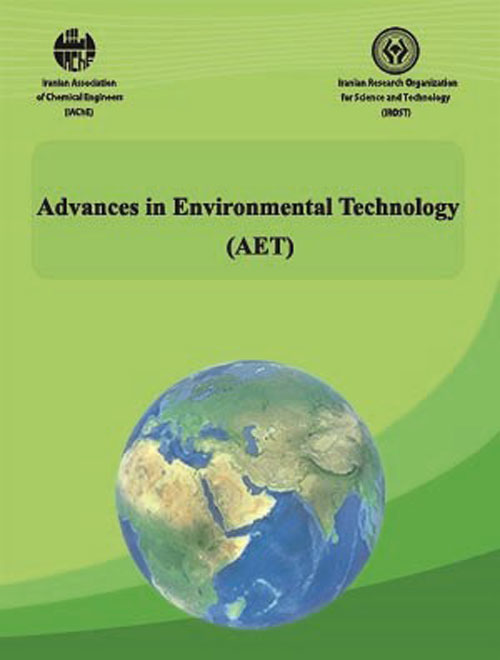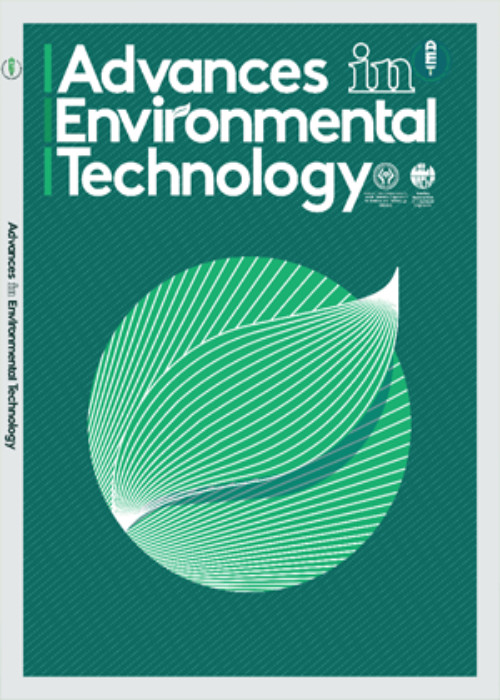فهرست مطالب

Advances in Environmental Technology
Volume:4 Issue: 1, Winter 2018
- تاریخ انتشار: 1397/08/30
- تعداد عناوین: 6
-
-
Pages 1-12Raw bentonite (RB), a known low-cost versatile clay was used as an adsorbent. RB was treated thermally and chemically to increase its adsorption capacity. For thermal treatment (TTB), the bentonite was heated at 400 °C for 60 min, and for the chemical modification, its surface was treated by cetyltrimethylammonium bromide (CTAB) to prepare organo-modified bentonite (CTAB-B). The removal of Congo red dye (CR) from aqueous solution was investigated in the batch mode. The prepared adsorbents were characterized by SEM, BET, and FTIR analyses. The effects of various experimental parameters such as contact time, pH, adsorbent dosage, dye concentration and temperature were investigated. The obtained results were in good agreement with the Langmuir isotherm model, and the maximum adsorption capacity of RB, TTB and CTAB-B was 43.1, 55.86 and 116.28 mg/g, respectively. The adsorption kinetic was better described by the pseudo-second order kinetic model. The results showed that thermally or chemically modified bentonite could be proposed as a low-cost adsorbent for the removal of CR from water.Keywords: Congo red, Bentonite, Langmuir, Adsorption, Thermally, chemically modification
-
Pages 13-22Nanoporous carbons (CMK-3) were prepared and have been used as a fiber coating for headspace solid phase microextraction (HS-SPME). The prepared materials were characterized by Scanning Electron Microscopy (SEM), X-Ray Diffraction (XRD) and N2 adsorption/desorption isotherms. The efficiency of the fiber was evaluated using a gas chromatography (GC) system for the extraction of benzene (B) and chlorobenzenes (CBs) from the headspace of aqueous samples. The prepared nanomaterial was coated onto a copper wire for fabrication of the SPME fiber. These fibers featured advantages like easy and fast preparation, high thermal and mechanical stability. To optimize different parameters which influence the extraction efficiency such as sample volume, extraction temperature, extraction time, ionic strength and stirring rate, a Taguchi OA16 (45) orthogonal array experimental design was used. Based on the results obtained from the analysis of variance (ANOVA), the optimum conditions for extraction were established as: 12 mL sample volume; laboratory temperature; 20 % (w/v) NaCl; 35 min extraction time and stirring rate of 600 rpm. Under the optimized conditions for B and CBs, the linearity was from 2.5 to 800 µg/L, the relative standard deviation (RSD %) of the method was between 5.2 and 9.3% and limit of detections (LODs) was between 0.09 and 0.28 µg/L. The recovery values were from 85.40% to 104.20 % in water samples. Finally, the applicability of the proposed method was evaluated by the extraction and determination of B and CBs in the water samples.Keywords: Chlorobenzene Compounds, Solid-Phase Microextraction, Ordered Nanoporous, Orthogonal Array Designs
-
Pages 23-40Granular activated carbon (OSAC) which was derived from olive oil industrial solid waste was chemically activated with different concentrations of phosphoric acid. OSAC-materials were evaluated for their ability to remove phenol from aqueous solution in a batch technique. Adsorption isotherms were determined and modeled with five linear Langmuir forms, namely the Freundlich, Elovich, Temkin, Kiselev and Hill-de Boer models. The experimental data for the adsorption of phenol onto OSAM-materials were fitted well with the Langmuir-1 and 2, Freundlich, Kiselev and Hill-de Boer models. Adsorption was carried out on energetically different sites as localized monolayer adsorption and was an exothermic process. The uptake of phenol onto OSAC increased in the following order: OSAC-80%> OSAC-70%> OSAC-60%; the maximum adsorption capacities of phenol were found to be 114.416, 125.628 and 262.467 mg/g onto OSAC-60%, OSAC-70% and OSAC-80%, respectively. On the other hand, OSAC-80% was used as a good adsorbent for the removal of phenol and Cd2+ as co-pollutants from waste aqueous solutions. 80.25% of phenol and 50.66% of Cd2+ can be simultaneously removed by OSAC-80%.Keywords: Phenol, Co-pollutants, Isotherm, kinetic models, activated carbon, Adsorption
-
Pages 41-49The concentrations of toxic effluents released into freshwater aquatic environments are increasing day by day and affect the aquatic biota. The present study outlined the evaluation of physicochemical parameters such as water temperature, pH, dissolved oxygen (DO), biological oxygen demand (BOD), chemical oxygen demand (COD), phosphates (PO42--P), nitrates (NO3--N), electrical conductivity (EC) chlorides (Cl-). Also, the Water Quality Index (WQI) for the water samples collected from the selected stations of the Yamuna River was calculated in order to assess its suitability for drinking, irrigation and agricultural purposes. The Weighted Arithmetic Index method was used to calculate the WQI. The WQI was found to be above 100 at all three stations, which was critical and indicated that the water quality grading fell in the E category, which made the water unsuitable for drinking and agricultural purposes. The assessment of physicochemical parameters indicated that the selected stations were badly impacted by industrial effluents and domestic sewage; thus, the river water should be treated before use to avoid water-related diseases that can have harmful effects on humans and aquatic biota.Keywords: Yamuna River, water pollution, water quality index (WQI), physicochemical parameters, arithmetic index method
-
Pages 51-60A simple and fast electrochemical method was described and evaluated for the determination of hazardous compound, 4-nitrophenol. In this work, trace amounts of 4- nitrophenol were determined by square – wave voltammetry. A glassy carbon electrode was modified with multi-walled carbon nanotubes and copper nanoparticles. A synergistic effect was observed between Cu nanoparticles and carbon nanotubes which resulted in enhanced oxidation peak current of 4-nitrophenol. The modified electrode showed more sensitivity towards 4-nitrophenol compared to unmodified one. A wide linear concentration range from 0.2 to 298.0 μM was obtained for 4-nitrophenol with a detection limit of 0.06 μM. Reproducibility and repeatability of the method were evaluated for determination of 4-nitrophenol (0.1 mM) as 3.47% and 2.30%, respectively (relative standard deviation, RSD %), which are acceptable. The method was applied to the analysis of 4- nitrophenol (22.2 μM) in spiked river water samples, successfully. Simplicity, sensitivity, selectivity and high efficiency of the proposed method can be used in routine analysis of trace amounts of 4-nitrophenol in polluted waters.Keywords: 4-Nitrophenol, Square wave voltammetry, Copper nanoparticles, Multi-Walled Carbon Nanotubes, River water samples
-
Pages 61-73In this paper, cyclic voltammetry (CV) was used to study the effects of operating parameters (i.e., sulfide concentration, sodium chloride concentration as supporting electrolyte, temperature, mixing speed, and potential scan rate) on the anodic oxidation of synthetic sulfide-containing wastewaters at the surface of a platinum electrode. The results revealed that anodic oxidation could be used to eliminate sulfide from wastewaters in a wide concentration range, and the oxidation current was an ascending function of the sulfide concentration. The supporting electrolyte concentration had a negligible effect, as the sulfide dissociated in the aqueous media and brought electrical conductivity to the solution. The optimum concentration of electrolyte was found to be 0.05 mol/L. Increasing temperature improved the kinetics of the oxidation reactions and enhanced the electrical conductivity of the solution, which resulted in increasing the anodic oxidation rate. However, at higher temperatures, undesired side reactions were activated which resulted in lowering the power efficiency of the desired anodic oxidation reactions. The optimum operating temperature was found to be 40 – 60 °C. The mixing speed had a periodic effect on the sulfide oxidation. It decreased the diffusion resistance and also the residence time of sulfide at the electrode surface. These phenomena affected the anodic oxidation oppositely and hence, a middle value around 200 rpm was found to be the optimum. By increasing the potential scan rate, the time of performing the reactions in each cycle increased and the overall oxidation progress improved. It was found that mass transfer resistance was a limiting step in the overall reaction. Based on the findings, anodic oxidation has the potential for treating sulfide-containing wastewaters and in the future may be a competitor for conventional treatment processes.Keywords: Wastewater treatment, Electrochemical oxidation, Anodic oxidation, Cyclic voltammetry, Sulfide pollutant


